| Cephalanthera rubra | |
|---|---|
 | |
| Scientific classification | |
| Kingdom: | Plantae |
| Clade: | Tracheophytes |
| Clade: | Angiosperms |
| Clade: | Monocots |
| Order: | Asparagales |
| Family: | Orchidaceae |
| Subfamily: | Epidendroideae |
| Genus: | Cephalanthera |
| Species: | C. rubra |
| Binomial name | |
| Cephalanthera rubra | |
| Synonyms[1] | |
| |
Cephalanthera rubra, known as red helleborine,[2] is an orchid found in Europe, North Africa and southwest Asia. Although reasonably common in parts of its range, this Cephalanthera has always been one of the rarest orchids in Britain.
Description
Each flowering shoots reach 20–70 cm height. The shoots grow from a creeping rhizome. The stem is smooth at the base and densely covered with short glandular hairs higher up. The shoots have between 2 and 8 lanceolate leaves which range in size from 5 to 14 cm long and from 1 to 3 cm wide. Each shoot may carry up to 20 flowers, which may be pink to red or rarely white. They are up to 5 cm wide. The petals are curved and lanceolate. Flowers are produced from May to July.[3] It is known to sometimes go many years without flowering. Chromosomes 2n=36
Not to be confused with Epipactis atrorubens (dark red helleborine).

Distribution and habitat
The red helleborine is found throughout most of Europe, east to the Urals and as far as 60 degrees north. It is however rare in Britain, the Low Countries and western France. It also occurs in Morocco, Algeria and Tunisia and in various parts of southern Asia as far east as Iran.[4][1][5]
Found in light, dry forest, particularly among beech trees, pines and spruces. grows to an altitude of 2,600 m (8,500 ft), especially on calcareous soils with a pH between 5.9–8.2. Flower colour is an indicator of the soil qualities, with darker blooms on more calcareous ground.
Red helleborine is a very rare plant in Britain. It is found only at the following sites:
- Workman's Wood, Sheepscombe, Gloucestershire[6][7][8]
- Hawkley Warren, Hampshire,[6] where it was first found in 1986.[9]
- Windsor Hill SSSI, a woodland just to the east of Princes Risborough in the Chilterns, Buckinghamshire[6][10]
During the 19th and early 20th centuries, the species was recorded from single sites in Somerset, Sussex and Kent, and a second Hampshire site (in the upper Test Valley). The species was also recorded at additional Gloucestershire sites (including Stanley Wood, King's Stanley, now a Woodland Trust woodland), and persisted at some of these into the 1970s. It became a protected species in the UK in 1975 under the Conservation of Wild Creatures and Wild Plants Act.[11]
Ecology
Cephalanthera rubra is thought to be mainly pollinated by flies, although often self-pollination is triggered by rainfall.[12] Pollination may also be carried out by Chelostoma bee (Chelostoma campanularum?) and the weevil Miarus campanulae, both of which are thought to mistake the flowers for Campanula persicifolia, a wildflower found on mountains in continental Europe. It is theorised that C. rubra mimics C. persicifolia to increase pollination early in the year.[12]
As the flowers are frequently visited by flies, crab spiders have been observed hunting in them.[12]
C. rubra forms a mycorrhizal relationship with species in the genera Leptodontidium, Phialophora and Tomentella. This enables it to access soil nutrients which would otherwise be unavailable.[13]
Etymology
Cephalanthera comes from the Greek κεφαλή ανθηρός, meaning "head flowering", thought to be a reference to the protruding position of the anthers. The species epithet rubra comes from the Latin for red, referring to the colour of the flowers. The Latin binomial was chosen by a French botanist named Professor Louis Claude Marie Richard.
"Helleborine" may refer to deer using the orchid for food (many conservationists have noted that helleborine orchids are grazed by deer [14][15][16]). Alternatively it may denote that the plants are similar to hellebores (a group of species in the family Ranunculaceae). "Hellebore" comes from the Greek "álkē" and "bora", translating as "fawn" and "food of beasts".[17]
In German, Cephalanthera are referred to as Waldvöglein, meaning little birds of the wood, a reference to the winged appearance of the flowers.
References
- 1 2 Kew World Checklist of Selected Plant Families
- ↑ BSBI List 2007 (xls). Botanical Society of Britain and Ireland. Archived from the original (xls) on 2015-06-26. Retrieved 2014-10-17.
- ↑ First Nature - Cephalanthera rubra
- ↑ Harrap, Anne and Simon (2005). Orchids of Britain and Ireland: a Field and Site Guide. A&C Black. pp. 134–40. ISBN 0-7136-6956-X.
- ↑ Altervista Flora Italiana, Cefalantera rossa, Red Helleborine, Cephalanthera rubra
- 1 2 3 Species distribution map for Cephalanthera rubra Archived 2016-11-04 at the Wayback Machine, NBN Gateway, retrieved 25 February 2010
- ↑ Kitchen, Clare, Mark A. R. Kitchen and Ian Carle (2008) Stephen Bishop's New Flora of Gloucestershire Part 2: the distribution maps The Gloucestershire Naturalist No. 14 Gloucestershire Naturalists ' Society, page 232
- ↑ Fisher, John (1991) A colour guide to rare wild flowers ISBN 0-09-470780-4 Constable books, London
- ↑ Rose, F. and A. Brewis (1988) Short notes: Cephalanthera rubra in Hampshire Archived July 26, 2011, at the Wayback Machine Watsonia 17: 176-77
- ↑ Ratcliffe, D. A. (1977) A Nature Conservation Review Volume 2. Site Accounts p. 53 ISBN 0-521-21403-3
- ↑ "Caithness CWS - Caithness Field Club - Annual Bulletins - 1975 - October - Conservation".
- 1 2 3 Beobachtung von Miarus campanulae als Bestäuber von Cephalanthera rubra
- ↑ Proceedings of the Royal Society B: Changing Partners in the Dark: Isotopic and Molecular Evidence of Ectomycorrhizal Liaisons between Forest Orchids and Trees
- ↑ Plantlife - Epipactis youngiana
- ↑ "Wildflower Society Online Report". Archived from the original on 2018-12-06. Retrieved 2018-12-06.
- ↑ Finnish Orchids
- ↑ Dictionary.com
